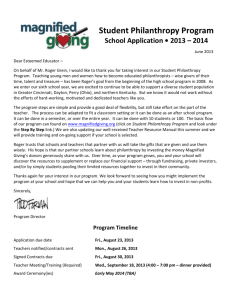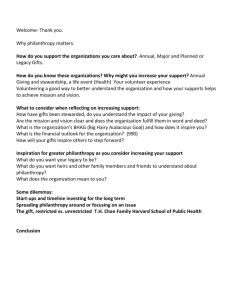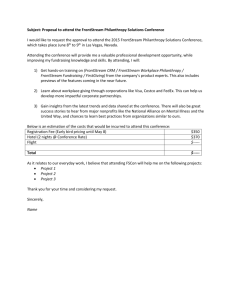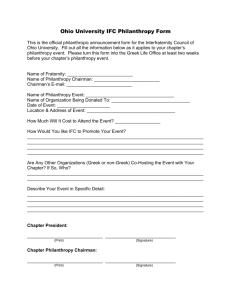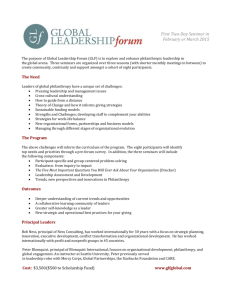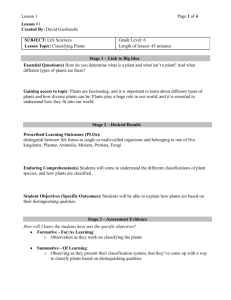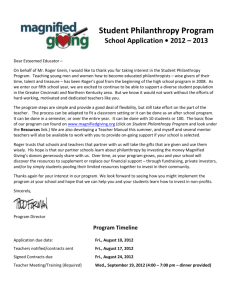Student Philanthropy Program
advertisement
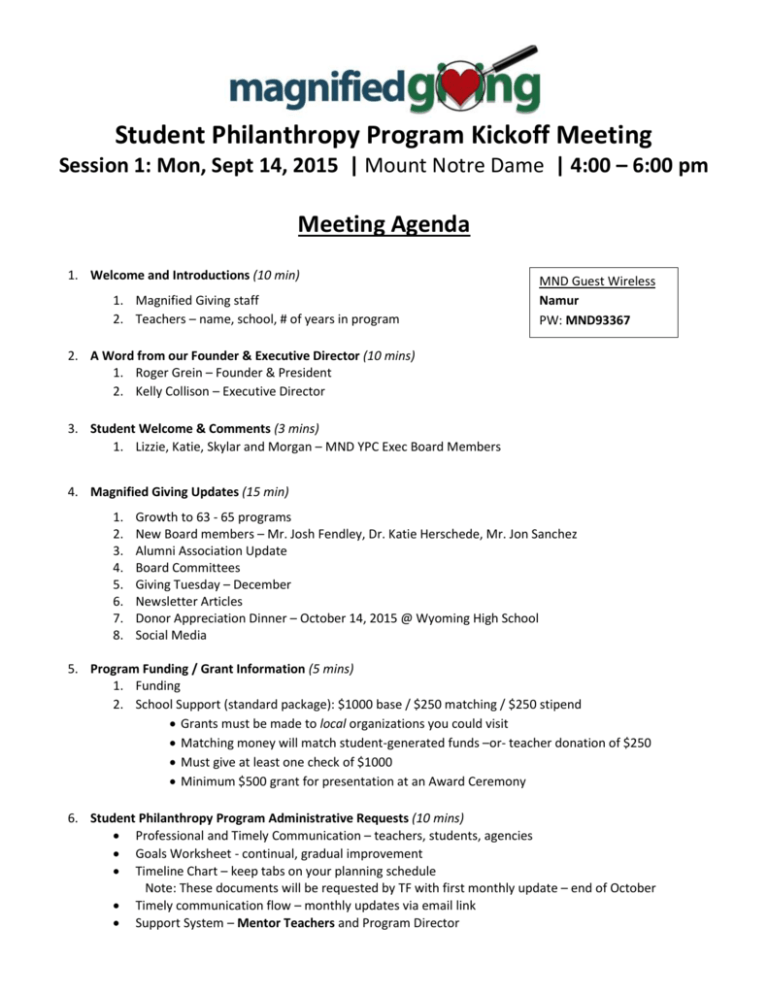
Student Philanthropy Program Kickoff Meeting Session 1: Mon, Sept 14, 2015 | Mount Notre Dame | 4:00 – 6:00 pm Meeting Agenda 1. Welcome and Introductions (10 min) 1. Magnified Giving staff 2. Teachers – name, school, # of years in program MND Guest Wireless Namur PW: MND93367 2. A Word from our Founder & Executive Director (10 mins) 1. Roger Grein – Founder & President 2. Kelly Collison – Executive Director 3. Student Welcome & Comments (3 mins) 1. Lizzie, Katie, Skylar and Morgan – MND YPC Exec Board Members 4. Magnified Giving Updates (15 min) 1. 2. 3. 4. 5. 6. 7. 8. Growth to 63 - 65 programs New Board members – Mr. Josh Fendley, Dr. Katie Herschede, Mr. Jon Sanchez Alumni Association Update Board Committees Giving Tuesday – December Newsletter Articles Donor Appreciation Dinner – October 14, 2015 @ Wyoming High School Social Media 5. Program Funding / Grant Information (5 mins) 1. Funding 2. School Support (standard package): $1000 base / $250 matching / $250 stipend Grants must be made to local organizations you could visit Matching money will match student-generated funds –or- teacher donation of $250 Must give at least one check of $1000 Minimum $500 grant for presentation at an Award Ceremony 6. Student Philanthropy Program Administrative Requests (10 mins) Professional and Timely Communication – teachers, students, agencies Goals Worksheet - continual, gradual improvement Timeline Chart – keep tabs on your planning schedule Note: These documents will be requested by TF with first monthly update – end of October Timely communication flow – monthly updates via email link Support System – Mentor Teachers and Program Director 7. Teacher Resource Manual – Online (5 mins) www.magnifiedgiving.org/resources 8. Student Philanthropy Program - Step-by-Step Review/Discussion (25 mins) 1. The First Steps 2. Structuring Your Group 3. Exploring Social Causes 4. Agency Research 5. Agency Contact 6. Grant Application Analysis + Site Visits 7. Presenting the Research 8. Choosing Winner(s) 9. Notifying Agencies 10. Awards Ceremonies 9. Important Program Dates (3 mins) Monthly updates – Program Director will send email request with link to online form Awards Ceremonies – April and May 2016 Student Online Survey – May 2016 (or at end of the your program) Final Teacher Report – June 2016 Stipends Issued – After receiving Final Report 10. Small Group Meetings/Sharing led by mentors (30 mins) MENTOR TEACHERS (for new teachers) Heather Campbell (Lakota) Julie Vehorn (Roger Bacon) Al Kovacic (Seton) Justin Yankech (Central Catholic) Casey Curtis (East Clinton) Todd Forman (Mount Notre Dame) campbellh@butlertech.org JVehorn@rogerbacon.org kovacica@setoncincinnati.org jyankech@ccirish.org casey.curtis@eastclinton.org todd@magnifiedgiving.org Homework Schedule a time for Roger Grein to come speak to your group Review online Teacher Resource Manual New teachers connect with MENTOR TEACHER to review your plan Fill out your Goals Worksheet and Implementation Timeline Contact Todd Forman any time you have any questions Enjoy knowing that you are going to have an amazing impact on many lives this year! THANK YOU FOR HELPING TOUCH HEARTS & MINDS! Student Philanthropy Program – Step-by-Step Step 1: The First Steps • Review the Teacher Manual – www.magnifiedgiving.org/resources • Determine how you will structure your program (club, class) • Put together your plan for the year – work on Goals Page and Timeline page • Determine how you will teach content • PRE-TEST (OPTIONAL) – The Pre-Test (and Post-Test) are optional again this year. www.magnifiedgiving.org/pretest. I can send you the results. • Schedule Roger to speak at your school. • Have your students register on our website – www.magnifiedgiving.org/studentregistration. Step 2: Structuring Your Group • Great Manual resources and ideas! • Determine if and how you are going to divide up your group • Review the Case Studies in the manual for ideas Step 3: Exploring Social Causes • Great Manual resources! • Determine if you want to explore all issues or focus on a handful or just one • SOCIAL CAUSE LIST You can use the Qualified Agencies Page found at www.magnifiedgiving.org/qualified to see a list of social causes. Step 4: Agency Research • Great Manual resources • Use a variety of methods and use links found on our website • Make sure students are exposed to and explore a wide-variety of agencies – not just a handful. Step 5: Agency Contact • Great Manual resources and ideas! • FOCUS ON PROFESSIONALISM – feedback from non-profits continues to indicate this is where we need to focus the most. Students need to be taught how to make proper site visits, keep agencies in the loop and professionally notify them if they did or did not receive the grant. • Determine communication system that will work for your students. • Encourage variety in the agencies you are exploring. We don’t want your students giving money to the same two or three organizations year after year. Phase One: Identifying Potential Non-Profits, Initial Contact QUALIFIED AGENCIES: Agencies must be “Qualified” and listed on our website in order to be considered for grant. The list of qualified agencies to date can be found at www.magnifiedgiving.org/qualified. Students are asked to ask let new agencies they discover register on our site so the agency can become eligible for a grant – not only from your school, but from the other participating schools. We have provided a pre-written body of text that students can copy/paste and send to a non-profit to encourage them to register. They can also call the agency as well. • REMIND STUDENTS TO CHANGE TEXT COLOR/ITALICS WHEN USING THE FORM LETTER REGISTRATION: Agencies register via our website (www.magnifiedgiving.org/register). Once they register, we post their info to our site and they become “Qualified”. This means they are now eligble for schools to send them a Grant Application invitation. Phase Two: Formal Grant Application Invitation INVITING AGENCIES TO OFFICIALLY APPLY FOR YOUR GRANT: Once students narrow down choices, they officially invite agencies to fill out a grant application that is specific for your school. The Grant Applications can be found at www.magnifiedgiving.org/grantapplications. The letter students send can be found at www.magnifiedgiving.org/standardcommunication. • LIMIT THE NUMBER OF AGENCIES STUDENTS INVITE TO COMPLETE THE GRANT APPLICATION. • MAKE SURE DUE DATE IS A MINIMUM OF 3-WEEKS AFTER INVITATION IS SENT. NOTIFICATIONS: Once an agency fills out your grant, you will receive an email copy of that application. You can forward to your other teachers and students in your group. Step 6: Grant Application Analysis + Site Visits • Great Manual resources • Determine how your students will review the applications they receive • Use master chart for organizing information • Determine how site visits can work into your program • Review the chapter on Site Visits and discuss with students Step 7: Presenting the Research • Great Manual resources • Determine how your students will share their findings Step 8: Choosing a Winner • Great Manual resources • Have students determine the best voting system to use Step 9: Notifying the Agencies • Great Manual resources • FOCUS on Professionalism • Students will download, update and send Standard Rejection Letter • Students will download, update and send Standard Congratulations Letter • REMIND STUDENTS TO CHANGE TEXT COLOR/ITALICS WHEN USING THE FORM LETTER • Both letters can be found at www.magnifiedgiving.org/standardcommunication Step 10: Award Ceremonies (Several to choose from) • Teacher, Students, parents, principal, potential donors, and AGENCY REP (required) invited • Award Ceremonies – Dates and locations coming soon • Student Wrap-Up: End of the Program Student Survey – REQUIRED Post Test – OPTIONAL again this year. Small Group time Mentor teachers will lead discussion. New teachers will be divided up among the three mentors at each session. The following are a few possible discussion questions to pose to the group: 1. What questions do people have from the training session? 2. How are you planning to implement the Philanthropy Program this school year (how have you done it in the past)? 3. For returning teachers: What is something you plan on doing differently this year? What part of the program will you definitely incorporate again this year? 4. For new teachers: How did you find out about the Philanthropy Program and what are you hoping it will bring to your classroom or building? 5. What challenges have you faced in the past or what can you foresee as a possible challenge as you implement the Philanthropy Program this year? 6. What successes have you experienced in the past or do you hope to experience this year? 7. Go over Program Goals Worksheet Handout and Timeline Worksheet. Talk about the Beginning/Building/Excellent levels of schools and discuss setting goals for these areas.

